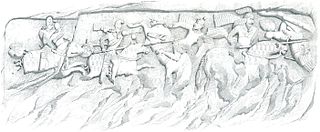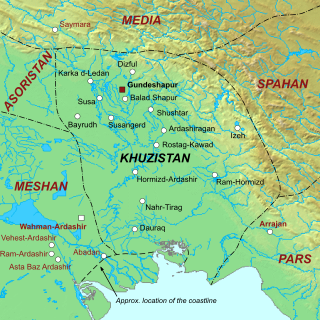
Khosrow I, traditionally known by his epithet of Anushirvan, was the Sasanian King of Kings of Iran from 531 to 579. He was the son and successor of Kavad I.

Hormizd-Ardashir, better known by his dynastic name of Hormizd I, was the third Sasanian King of Kings (shahanshah) of Iran, who ruled from May 270 to June 271. He was the third-born son of Shapur I, under whom he was governor-king of Armenia, and also took part in his father's wars against the Roman Empire. Hormizd I's brief time as ruler of Iran was largely uneventful. He built the city of Hormizd-Ardashir, which remains a major city today in Iran. He promoted the Zoroastrian priest Kartir to the rank of chief priest (mowbed) and gave the Manichaean prophet Mani permission to continue his preaching.

Hormizd II was king (shah) of the Sasanian Empire. He ruled for seven years and five months, from 303 to 309. He was a son and successor of Narseh.

Hormizd III, was the seventeenth king (shah) of the Sasanian Empire, ruling briefly from 457 to 459. He was the son and successor of Yazdegerd II. His reign was marked by the rebellion of his younger brother Peroz I, who with the aid of one of the Seven Great Houses of Iran, the House of Mihran, and the eastern neighbours of the Sasanians, the Hephthalites, had him captured and executed.

Yazdegerd I was the Sasanian King of Kings of Iran from 399 to 420. A son of Shapur III, he succeeded his brother Bahram IV after the latter's assassination.

Bahram I was the fourth Sasanian King of Kings of Iran from 271 to 274. He was the eldest son of Shapur I and succeeded his brother Hormizd I, who had reigned for a year.

Bahram II was the fifth Sasanian King of Kings (shahanshah) of Iran, from 274 to 293. He was the son and successor of Bahram I. Bahram II, while still in his teens, ascended the throne with the aid of the powerful Zoroastrian priest Kartir, just like his father had done.

Bahram IV, was the Sasanian King of Kings of Iran from 388 to 399. He was likely the son and successor of Shapur III.

Shapur I was the second Sasanian King of Kings of Iran. The dating of his reign is disputed, but it is generally agreed that he ruled from 240 to 270, with his father Ardashir I as co-regent until the death of the latter in 242. During his co-regency, he helped his father with the conquest and destruction of the Arab city of Hatra, whose fall was facilitated, according to Islamic tradition, by the actions of his future wife al-Nadirah. Shapur also consolidated and expanded the empire of Ardashir I, waged war against the Roman Empire, and seized its cities of Nisibis and Carrhae while he was advancing as far as Roman Syria. Although he was defeated at the Battle of Resaena in 243 by Roman emperor Gordian III, he was the following year able to win the Battle of Misiche and force the new Roman Emperor Philip the Arab to sign a favorable peace treaty that was regarded by the Romans as "a most shameful treaty".

Shapur II, also known as Shapur the Great, was the tenth Sasanian King of Kings (Shahanshah) of Iran. The longest-reigning monarch in Iranian history, he reigned for the entirety of his 70-year life, from 309 to 379. He was the son of Hormizd II.

Shapur III, was the Sasanian King of Kings of Iran from 383 to 388. He was the son of Shapur II and succeeded his uncle Ardashir II.

Ardashir II, was the Sasanian King of Kings of Iran from 379 to 383. He was the brother of his predecessor, Shapur II, under whom he had served as vassal king of Adiabene, where he fought alongside his brother against the Romans. Ardashir II was appointed as his brother's successor to rule interimly till the latter's son Shapur III reached adulthood. Ardashir II's short reign was largely uneventful, with the Sasanians unsuccessfully trying to maintain rule over Armenia.

Narseh was the seventh Sasanian King of Kings of Iran from 293 to 303.

Artabanus IV, also known as Ardavan IV (Parthian:𐭓𐭕𐭐𐭍), incorrectly known in older scholarship as Artabanus V, was the last ruler of the Parthian Empire from c. 213 to 224. He was the younger son of Vologases V, who died in 208.

Kartir was a powerful and influential Zoroastrian priest during the reigns of four Sasanian kings in the 3rd-century. His name is cited in the inscriptions of Shapur I and the Paikuli inscription of Narseh. Kartir also had inscriptions of his own made in the present-day Fars Province. His inscriptions narrates his rise to power throughout the reigns of Shapur I, Hormizd I, Bahram I, and Bahram II. During the brief reign of Bahram II's son and successor Bahram III, Kartir was amongst the nobles who supported the rebellion of Narseh, who overthrew Bahram III and ascended the throne. During Narseh's reign, Kartir faded into obscurity.

The Battle of Hormozdgan was the climactic battle between the Arsacid and the Sasanian dynasties that took place on April 28, 224. The Sasanian victory broke the power of the Parthian dynasty, effectively ending almost five centuries of Parthian rule in Iran, and marking the official start of the Sasanian era.
Šahrestānīhā ī Ērānšahr is a surviving Middle Persian text on geography, which was completed in the late eighth or early ninth centuries AD. The text gives a numbered list of the cities of Eranshahr and their history and importance for Persian history. The text itself has indication that it was also redacted at the time of Khosrow II in 7th century as it mentions several places in Africa and Persian Gulf conquered by the Sasanians.

Hormizd I Kushanshah was Kushanshah of the Kushano-Sasanian Kingdom from 275 to 300. His reign was marked by his rebellion against his brother and suzerain the Sasanian King of Kings Bahram II.
The Temple of Anahita was an ancient fire temple in Istakhr dedicated to the worship of the Iranian goddess Anahid.

Khuzistan or Huzistan was a Sasanian province in Late Antiquity, which almost corresponded to the present-day province of Khuzestan. Its capital was Gundeshapur. During the late Sasanian era, the province was included in the southern quadrant (kust) of Nemroz.



















